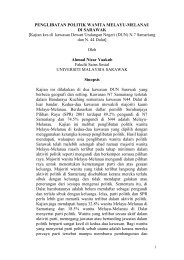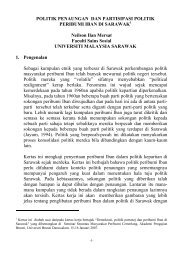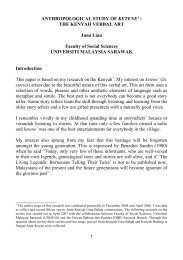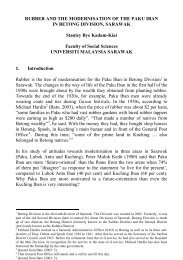OF SOUKHUAN AND LAOS Elena Gregoria Chai Chin Fern Faculty ...
OF SOUKHUAN AND LAOS Elena Gregoria Chai Chin Fern Faculty ...
OF SOUKHUAN AND LAOS Elena Gregoria Chai Chin Fern Faculty ...
Create successful ePaper yourself
Turn your PDF publications into a flip-book with our unique Google optimized e-Paper software.
The khuan<br />
The belief in khuan has long been a strong element in Lao culture. The word ‘Lao’<br />
used in this text describes the people of the Lao Loum group. The Lao still retain what<br />
most people consider as a pre-Buddhist belief in khuan or soul. Written material on<br />
this is very limited as books and were burnt during the Revolution of 1975 (pers.<br />
comm., Bounmihang [Lao National University]).<br />
The Lao people originated from southern <strong>Chin</strong>a. Phya Anuman Rajadhon (1968)<br />
linked the word khuan with the <strong>Chin</strong>ese (hwun). The concept of hwun is similar to<br />
those of khuan. For instance, in both cases, the absence of hwun will make one<br />
vulnerable to sickness and misfortune. In order to call one’s lost hwun, a (Chao<br />
Hwun) ceremony is performed. For thousands of years, calling the soul back to the<br />
body has been a custom in <strong>Chin</strong>a (Terwiel,1978:13). Ch’un Yuan wrote a poem<br />
sometime in the early third century B.C. called Chao hun or “summons of the soul”<br />
(Hawkes,1959:100). It is evident that the ritual is still performed now (Terwiel, ibid).<br />
Chao Hun was used in ancient <strong>Chin</strong>a to call the wandering soul of a sick man back to<br />
his body and also to summon the souls of the dead (Terwiel, ibid). When a baby is<br />
sick, a mother “hastens up to the roof of her house and, waving about a bamboo pole<br />
to which is affixed a garment belonging to the little one, exclaims several times in<br />
succession:<br />
“My child …. (child’s name), come back, return home! In the interim, another inmate<br />
of the house beats a gong loudly to arouse the attention of the soul. After a while, the<br />
vital spirits are expected to recognize the garment and slip into it; and so, along with<br />
it, they are taken back to the sufferer and placed either upon or at the side of his bed”<br />
(De Groot, 1892:243).<br />
This Chao Hwun ceremony for the sick child is similar to the Wankhuan ceremony<br />
performed by an elderly woman for her grandchildren as described in the following<br />
section. Although the paraphernalia of the ceremony is different in both cases, there is<br />
a similarity between the <strong>Chin</strong>ese and the Lao practices. The <strong>Chin</strong>ese perform the soul<br />
calling with the child’s garment while beating a gong, where as the Lao uses a fishing<br />
cage and a piece of smoldering wood. Both are used to call the return of the lost soul.<br />
The Lao ritual is a close resemblance to the <strong>Chin</strong>ese one.<br />
The word ‘khuan’ means ‘soul’. Clearly, any researcher who is keen in Lao culture<br />
could not help but be fascinated at how the social and religious belief of the Lao and<br />
their outlook on health and happiness are governed by the belief of khuan. Such belief<br />
is not restricted to the Lao; the Thai, the Burmese and other Tai-Lao speaking<br />
minorities occupying the Mekong Delta region also hold such belief. In fact, this<br />
belief could be traced to other races in Southeast Asia as well, for example, the Iban,<br />
- 7 -<br />
PDF Creator - PDF4Free v2.0<br />
http://www.pdf4free.com







